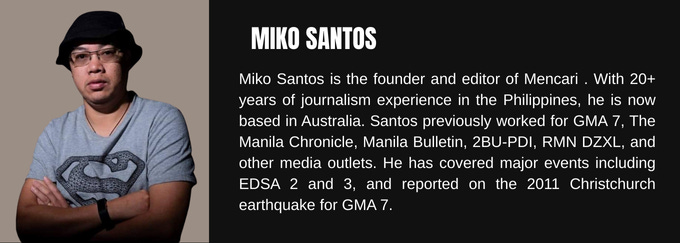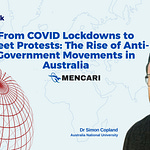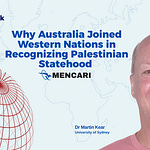Australia is implementing a social media ban for children under 16, and this interview with Associate Professor Dr. Lesley Anne Ey from UniSA Education Futures explains the developmental science behind the decision. Children’s brains are still developing executive functioning and critical thinking skills through their teenage years, making them vulnerable to sophisticated online predators, cyberbullying, misinformation, and harmful content ranging from pornography to eating disorder promotion.
The ban serves as a protective mechanism—similar to age restrictions on driving—to give children time to mature cognitively before facing these risks. However, Dr. Ey emphasizes that the ban alone isn’t enough. Media literacy education must become as important as math and English in schools, while parents need to educate themselves about online risks, maintain open communication with their children, and reassure them that no problem is too big to solve together. The interview explores whether the ban will effectively reduce harm or simply shift risks to platforms like gaming, and discusses why education remains the most powerful long-term protection strategy.
Truth matters. Quality journalism costs.
Your subscription to Mencari directly funds the investigative reporting our democracy needs. For less than a coffee per week, you enable our journalists to uncover stories that powerful interests would rather keep hidden. No corporate influence. No compromises. Just honest journalism when we need it most.
Five Key Takeaways
Cognitive Development Timeline Drives Policy: Children’s executive functioning skills and critical thinking abilities continue developing until around age 16-17, with peak sexual development occurring between ages 10-17, making adolescents particularly vulnerable to online risks including predatory behavior, misinformation, and content promoting self-harm or eating disorders during this crucial developmental window.
Comprehensive Risk Landscape Beyond Cyberbullying: Social media exposure encompasses far more than bullying—risks include sextortion (perpetrators coercing sexual images then using them for control), child sexual abuse, false information shaping perceptions, conspiracy theories, body image dysphoria, addiction, depression, suicidal ideation, and access to dangerous content like bomb-making instructions or hate speech.
Perpetrators Outpace Both Police and Children: Child sexual abuse perpetrators are sophisticated actors who remain consistently ahead of law enforcement detection methods, operating secretively and manipulating children through grooming techniques—if police struggle to identify and trap these perpetrators, expecting cognitively developing children to recognize and resist them is unrealistic without protective measures.
Education Trumps Regulation as Long-Term Solution: While the ban provides temporary protection, Dr. Ey emphasizes that media literacy education represents a more effective long-term strategy than regulation alone, arguing it should receive equivalent priority to mathematics and English in curricula, with systematic monitoring and assessment of what children learn about recognizing and responding to online risks.
Parental Communication Provides Critical Safety Net: Children who fall victim to online grooming or send compromising images often remain silent due to fear of consequences or punishment, sometimes resulting in tragic outcomes including suicide—parents must establish that no problem is too big to address together, creating an approachable environment where children feel safe reporting uncomfortable or suspicious online interactions immediately.
Detailed Synopsis
This interview examines Australia’s imminent social media ban for children under 16 through a conversation with Associate Professor Dr. Lesley Anne Ey, a child development expert from UniSA Education Futures. The discussion provides scientific context for the policy while exploring its practical implications and limitations.
Dr. Ey grounds the policy rationale in developmental psychology, explaining that while the internet offers tremendous opportunities for learning, connection, and entertainment, it also creates a risk environment for which children are neurologically unprepared. The adolescent brain undergoes significant development between ages 10-17, a period that coincides with both sexual maturation and the formation of executive functioning skills necessary for critical thinking and risk assessment.
The scope of online risks extends well beyond the commonly discussed cyberbullying. Dr. Ey catalogs a disturbing range of harms: sextortion schemes where perpetrators manipulate children into sending sexual images then use those images for ongoing control and abuse; direct child sexual exploitation; exposure to harmful instructional content including bomb-making guides; pornography; hate speech; misinformation campaigns; conspiracy theories deliberately designed to distort reality; content promoting negative body image and eating disorders; and platforms that facilitate addiction patterns while exacerbating depression and suicidal ideation.
Schools teach critical thinking, Dr. Ey notes, but primarily in academic contexts—problem-solving exercises and curriculum-based challenges. This educational approach doesn’t adequately prepare children to identify and respond to bad-faith actors, sophisticated manipulation tactics, or the psychological techniques employed by online predators. These perpetrators represent a particular challenge because they operate with deliberate deception and remain consistently ahead of law enforcement capabilities.
This creates what Dr. Ey characterizes as an impossible expectation: if trained police officers with specialized resources struggle to identify and apprehend child predators operating online, how can society reasonably expect cognitively developing children to recognize these same threats and protect themselves effectively?
The social media ban emerges from this analysis as a protective mechanism rather than a comprehensive solution. Dr. Ey draws an explicit parallel to driving age restrictions—society doesn’t permit children to drive until 16 not because driving is inherently wrong, but because children require time to develop the physical coordination, judgment, and risk assessment capabilities that safe driving demands. Similarly, the social media ban provides a developmental buffer period.
However, Dr. Ey repeatedly emphasizes that the ban alone represents only partial protection. Gaming platforms, text messaging, and other digital communication channels remain accessible and carry similar risks. This reality necessitates a comprehensive educational approach involving multiple stakeholders.
For parents, Dr. Ey outlines specific responsibilities: self-education about social media platforms and internet safety through resources like the eSafety Commissioner website; direct conversation with children about the reasons behind the ban and the specific risks it addresses; creating an approachable communication environment; and crucially, reassuring children that no mistake or problem is too serious to address together.
This last point receives particular emphasis. Dr. Ey explains that children who become victims of grooming or who make mistakes like sending compromising images often remain silent due to fear of parental anger or punishment. This silence allows abuse to continue and intensify. In worst-case scenarios, children overwhelmed by shame and fear have taken their own lives rather than face consequences they perceived as insurmountable. Establishing unconditional support and problem-solving partnership becomes a literal life-or-death communication priority.
Schools carry complementary responsibilities. Dr. Ey argues that media literacy education should receive equivalent curricular priority to mathematics and English. Current Australian curriculum includes these components, but without systematic monitoring, assessment, or verification that students are actually learning protective skills. This represents a fundamental pedagogical gap.
The educational approach must extend beyond traditional internet safety to encompass critical media literacy—teaching children to recognize false information, understand AI-generated content, identify manipulation tactics, and develop healthy skepticism about online interactions. Schools occupy a unique position to deliver this education systematically and universally.
When asked whether media literacy might prove more effective than regulation, Dr. Ey responds affirmatively. Teaching children to recognize and manage risk creates more durable protection than any regulatory framework. However, she qualifies this by noting that education requires time to take effect, while children face immediate risks. The ban buys time for educational interventions to work while children continue maturing.
Regarding the ban’s effectiveness in reducing cyberbullying specifically, Dr. Ey predicts mixed outcomes. Some children experiencing bullying will likely welcome the protection the ban provides by reducing harassment opportunities. However, bullying won’t disappear because alternative platforms remain accessible. The fundamental principle holds: reducing opportunity for harm represents improvement even when complete elimination isn’t achievable.
The interview addresses socioeconomic concerns about differential access creating inequality. Dr. Ey rejects this framing based on device penetration data—approximately 80% of children age eight and older possess mobile phone access, with tablets and computers providing additional access points through family devices and schools. The ubiquity of device access means essentially all children face online risks regardless of socioeconomic status. The ban therefore provides relatively equal protection across economic strata.
Throughout the conversation, Dr. Ey maintains that risk cannot be entirely eliminated. Perpetrators will adapt and migrate to unregulated platforms. Children will find ways to access restricted services. The internet’s fundamental architecture creates access opportunities that no regulatory framework can completely control.
This reality makes education paramount. Once devices enter children’s hands—which happens early and nearly universally—education about recognition, response, and reporting becomes the primary protective mechanism. Parents and schools must provide this education proactively, comprehensively, and with appropriate sophistication about the actual threats children face.
Dr. Ey predicts that as the ban implementation progresses, researchers will observe measurable reductions in online grooming incidents and cyberbullying statistics. While acknowledging the absence of pre-implementation research evidence, she anticipates the ban will demonstrate protective effects through post-implementation data analysis.
The interview concludes with Dr. Ey reiterating the central tension: regulation provides immediate but incomplete protection, while education offers more comprehensive long-term safety but requires time and consistent implementation. Effective child protection demands both approaches working in concert, with realistic expectations about what each mechanism can accomplish.
What Readers Will Learn
Child Development Science:
How executive functioning skills develop through adolescence and why this timeline matters for online safety
The relationship between sexual maturation (ages 10-17) and vulnerability to exploitation
Why critical thinking taught in academic contexts doesn’t automatically transfer to social risk assessment
Cognitive differences between adolescent and adult brains that affect decision-making and risk recognition
Comprehensive Risk Understanding:
The full spectrum of online harms beyond cyberbullying: sextortion, grooming, harmful content, misinformation, body image issues, and mental health impacts
How sophisticated perpetrators operate and why they consistently outpace law enforcement detection
The psychological manipulation tactics used to control children and prevent them from seeking help
Why gaming platforms and messaging services present similar risks to social media
Practical Parenting Strategies:
Specific resources for parent education (eSafety Commissioner materials)
How to create communication environments where children feel safe reporting problems
Language and approaches for discussing online risks without creating fear or shame
Why unconditional problem-solving partnerships can prevent tragic outcomes
Warning signs that children may be experiencing online abuse or manipulation
Educational Policy Implications:
Why media literacy should receive equivalent priority to core academic subjects
The gap between curriculum inclusion and actual learning outcomes in internet safety education
What comprehensive critical media literacy encompasses beyond basic internet safety
How schools can systematically teach recognition of false information, AI content, and manipulation
The distinction between academic critical thinking and applied risk assessment skills
Regulatory Framework Analysis:
How the under-16 ban functions as a developmental buffer mechanism
Realistic expectations about what regulation can and cannot accomplish
Why the ban provides protection despite not eliminating all risk
How regulatory measures interact with educational approaches for comprehensive protection
The parallel between age restrictions on driving and social media access
Communication Skills for Difficult Conversations:
How to discuss sextortion, grooming, and sexual abuse with children age-appropriately
Creating reporting pathways for children experiencing uncomfortable online interactions
Balancing protection with age-appropriate autonomy and skill development
Reassurance techniques that encourage disclosure rather than silence
How to respond when children have already made mistakes or been victimized
Long-Term Protection Strategies:
Why education represents a more effective long-term solution than regulation alone
How to balance immediate protective measures with developmental skill-building
The role of ongoing parent education as platforms and risks evolve
Creating family media use policies that adapt as children mature
Preparing children for eventual unrestricted internet access through gradual skill development
This is not a sponsored video/audio. A small commission will be paid to us if you purchase anything through some of the affiliate links in our product listings.
If you want to chat more about this topic, I would love to continue this conversation with you, over Twitter @realmikosantos!
This podcast is powered by Kangaroofern, Australia's Independent Podcast Management Company.
Thanks so much for listening to our podcast!
If you enjoyed this episode, be sure to subscribe so you'll be notified when a new episode is posted in the Apple podcast, Google podcast, Spotify, Stitcher or via RSS.
If you think others could benefit from listening, please share it on your socials.
You can also subscribe to the podcast app on your mobile device.
If you found value in this episode, leave us an Apple Podcast review. Ratings and reviews from our listeners are extremely valuable to us and greatly appreciated. They help our podcast rank higher on Apple Podcasts and expose our show to more awesome listeners like you.
This is a premium episode. If you would like to discuss this with other subscribers or get access to the episodes, visit Readmencari.com
Got a News Tip?
Contact our editor via Proton Mail encrypted, X Direct Message, LinkedIn, or email. You can securely message him on Signal by using his username, Miko Santos.
While mainstream media serves corporate interests, you deserve the truth.
Your Mencari subscription—less than a coffee per week—powers real independent journalism. Our reporters dig into the stories powerful people desperately want buried. No corporate masters. No political handlers. Just the uncomfortable truths that matter most right now.
This is journalism without compromise, funded directly by readers who refuse to be misled. If this reporting opened your eyes, hit Restack so others can see what they're missing.
Not ready to be paid subscribe, but appreciate the newsletter ? Grab us a beer or snag the exclusive ad spot at the top of next week's newsletter.













